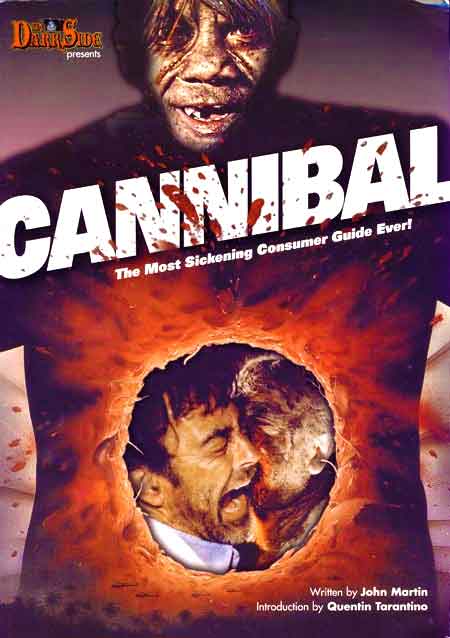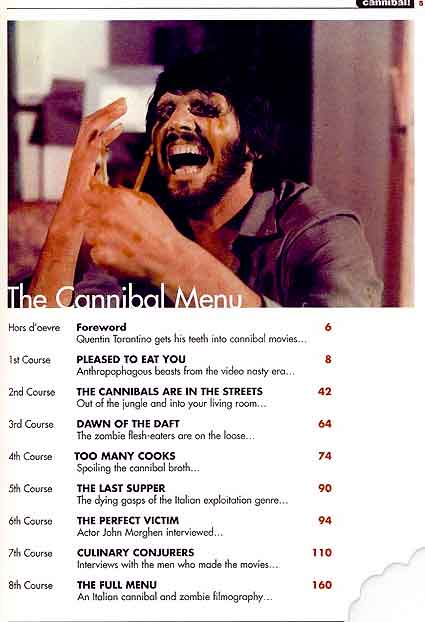 By JOHN MARTIN (Stray Cat Publishing; 2007)
By JOHN MARTIN (Stray Cat Publishing; 2007)
Before perusing this attractively formatted cannibal movie “Consumer Guide,” there are a couple of things one must keep in mind: 1). The book’s frame of reference is extremely limited, restricted to Italian cannibal movies made during the late seventies and early eighties, and 2). The much publicized “introduction” by Quentin Tarantino is actually just a mashup of quotes from an interview that appeared in the third issue of Giallo Pages magazine—which was edited by this book’s author, the British trash film enthusiast John Martin.
Martin provides a fast, user-friendly overview of the Italian cannibal film cycle in these pages, aided by extensive stills from the films in question. The cycle began with Umberto Lenzi’s DEEP RIVER SAVAGES/THE MAN FROM DEEP RIVER and hit its pinnacle with Ruggero Deodato’s CANNIBAL HOLOCAUST, before fizzling out with forgettable mid-eighties efforts like AMAZONIA and CANNIBAL MASSACRE IN DINOSAUR VALLEY. Such films were marked by extreme (even by modern standards) gore and mock-documentary overlays of a type made explicit in CANNIBAL HOLOCAUST (much of which actually takes the form of a mock-doc). Real life animal killings are another component of such movies, as are racist portrayals of the third world flesh eaters among whom these films’ “heroes” more often than not find themselves situated.
Martin also provides an overview of the Mondo film cycle that preceded the cannibal flicks, and, he argues, gave rise to them with their “dialectical transformation of neo-realism into its polar opposite”; to this end MONDO CANE, AFRICA ADDIO and GOODBYE UNCLE TOM are all given brief, and none-too-admiring, profiles. There are also a couple paragraphs about the “video nasties” scare that gripped England in the 80s and early 90s (about which Martin wrote a well-received book).
 A controversial element is Martin’s inclusion of films like Lucio Fulci’s ZOMBIE (identified here as ZOMBIE FLESH EATERS) and EROTIC NIGHTS OF THE LIVING DEAD, which (outside the fact that the zombies depicted in them have a tendency to eat human flesh) are not actually cannibal movies. An even bigger annoyance is Martin’s insistence on packing the text with “witty” lines like “While the cannibal chorus line wave their spears in the air and give it the old college cheer, he swallows the Morghen organ in one go—that’s what I call deep throating!” A comedian he’s not.
A controversial element is Martin’s inclusion of films like Lucio Fulci’s ZOMBIE (identified here as ZOMBIE FLESH EATERS) and EROTIC NIGHTS OF THE LIVING DEAD, which (outside the fact that the zombies depicted in them have a tendency to eat human flesh) are not actually cannibal movies. An even bigger annoyance is Martin’s insistence on packing the text with “witty” lines like “While the cannibal chorus line wave their spears in the air and give it the old college cheer, he swallows the Morghen organ in one go—that’s what I call deep throating!” A comedian he’s not.
CANNIBAL’S final pages consist of interviews (most of which initially appeared in Giallo Pages) with several of the “Culinary Conjurers” of the Italian cannibal film cycle, including Ruggero Deodato, Umberto Lenzi, Lucio Fulci, Joe D’Amato, producer Fabrizio de Angelis and actor John Morghen. In those interviews Lenzi comes off as a grump (“for me these films are not very important”) and D’Amato resolutely business-like and even-handed, while Lenzi and Deodato each take credit for instigating the cannibal film cycle, and Angelis seems a surprisingly reasonable guy (surprising because he’s disparaged in the Fulci interview as “a very mean man”).
Ultimately CANNIBAL isn’t bad, but it’s not great either. It’s enjoyable and informative enough, but far from the definitive Italian cannibal film resource it purports to be.
